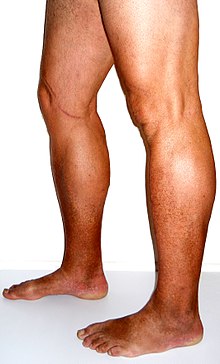
Back قصور وريدي مزمن Arabic Insuficiència venosa crònica Catalan Chronisch-venöse Insuffizienz German نارسایی مزمن وریدی Persian Krooninen laskimoiden vajaatoiminta Finnish Insuffisance veineuse French Insufficienza venosa cronica Italian 慢性静脈不全 Japanese 만성 정맥부전 Korean Veneuze insufficiëntie Dutch
This article needs additional citations for verification. (October 2020) |
| Chronic venous insufficiency | |
|---|---|
| Other names | Chronic venous disease |
 | |
| Mild chronic venous insufficiency, with increased pigmentation of the lower legs. | |
| Specialty | Vascular surgery |
Chronic venous insufficiency (CVI) is a medical condition in which blood pools in the veins, straining the walls of the vein.[1] The most common cause of CVI is superficial venous reflux which is a treatable condition.[2] As functional venous valves are required to provide for efficient blood return from the lower extremities, this condition typically affects the legs. If the impaired vein function causes significant symptoms, such as swelling and ulcer formation, it is referred to as chronic venous disease.[3] It is sometimes called chronic peripheral venous insufficiency and should not be confused with post-thrombotic syndrome in which the deep veins have been damaged by previous deep vein thrombosis.
Most cases of CVI can be improved with treatments to the superficial venous system or stenting the deep system. Varicose veins for example can now be treated by local anesthetic endovenous surgery.
Rates of CVI are higher in women than in men.[4][5] Other risk factors include genetics, smoking, obesity, pregnancy, and prolonged standing.[6]
- ^ "Chronic Venous Insufficiency". Society for Vascular Surgery. December 1, 2009. Archived from the original on January 17, 2016. Retrieved November 13, 2010.
- ^ Whiteley MS (2011). "Understanding Venous Reflux - the cause of varicose veins and venous leg ulcers". Whiteley Publishing. Archived from the original on October 25, 2017. Retrieved January 8, 2015.
- ^ Patel S, Surowiec S (2022). "Venous Insufficiency". National Center for Biotechnology Information, U.S. National Library of Medicine. PMID 28613694. Retrieved 9 July 2021.
- ^ Evans CJ, Fowkes FG, Ruckley CV, Lee AJ (1999). "Prevalence of varicose veins and chronic venous insufficiency in men and women in the general population: Edinburgh Vein Study". Journal of Epidemiology & Community Health. 53 (3). J Epidemiol Community Health.: 149–153. doi:10.1136/jech.53.3.149. PMC 1756838. PMID 10396491.
- ^ Robertson LA, Evans CJ, Lee AJ, Allan PL, Ruckley CV, Fowkes FG (May 2014). "Incidence and risk factors for venous reflux in the general population: Edinburgh Vein Study. Eur J Vasc Endovasc Surg. 2014 Aug;48(2):208-14. doi: 10.1016/j.ejvs.2014.05.017. Epub 2014 Jun 18". European Journal of Vascular and Endovascular Surgery. 48 (2). Eur J Vasc Endovasc Surg.: 208–14. doi:10.1016/j.ejvs.2014.05.017. PMID 24951373. Retrieved January 8, 2015.
- ^ Cite error: The named reference
statswas invoked but never defined (see the help page).
© MMXXIII Rich X Search. We shall prevail. All rights reserved. Rich X Search